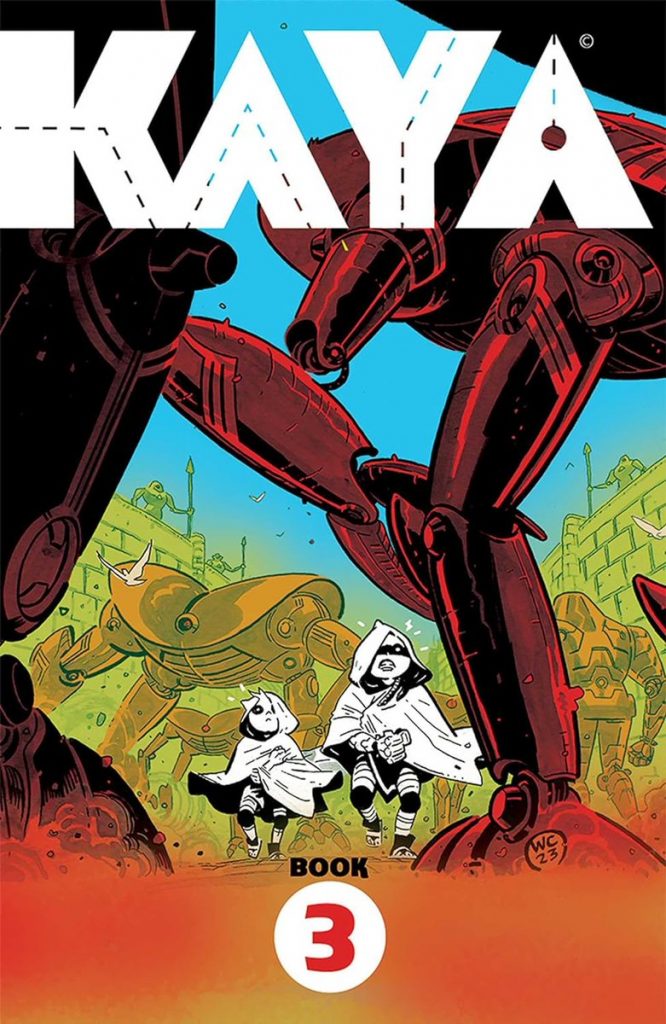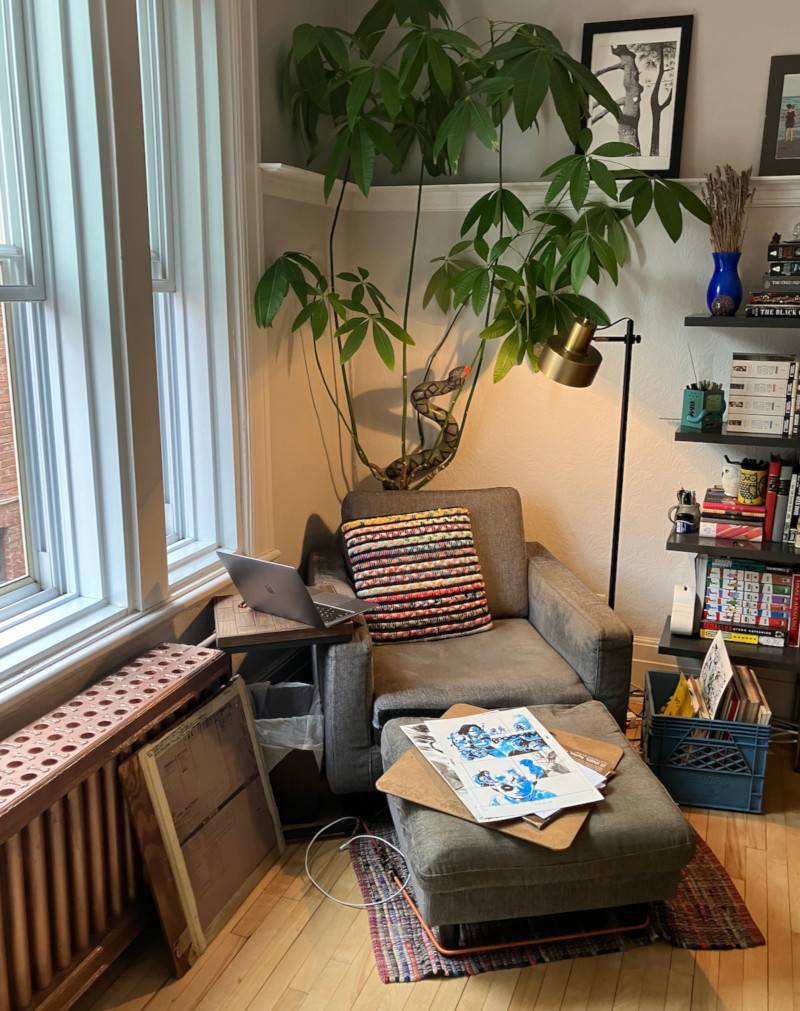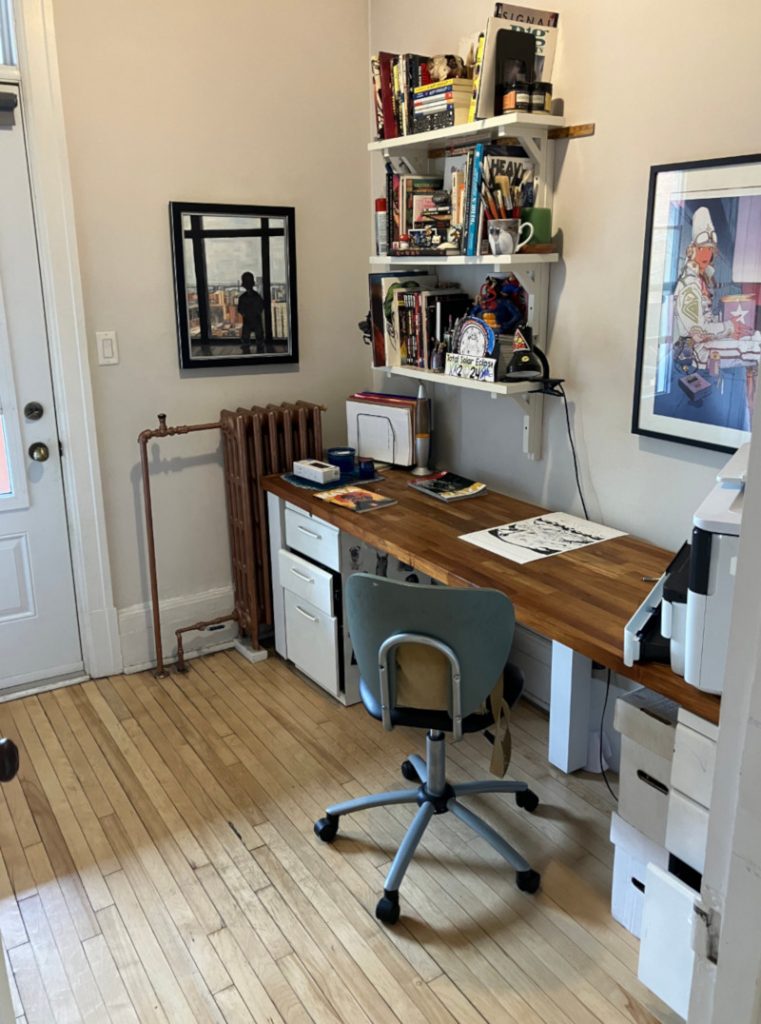How They Work with Wes Craig
Every person is different, and because of that, every comic creator is different. And with those differences in individuals comes differences in how they do the actual work, from their workspaces and processes to the tools and entertainment that keep them company throughout. This kind of thing always fascinates me, as does getting an inside look at the spaces they operate within.
That interest is where this new, hopefully semi-regular column — named “How They Work” — comes from. The idea is that this will be a recurring interview column, one where different creators will offer insight and looks inside their work and workspace, and that it’ll be an interesting peek behind the curtains in the process.
It certainly was in this first edition of the column, as the cartoonist behind one of my favorite ongoing series right now — Wes Craig, whose ongoing fantasy series Kaya has its 19th issue and third volume arriving this week and July 9th respectively from Image Comics — joined me in debuting this new venture. And Craig proved to be an ideal fit, both because the perspective he offered was excellent and because…he works in an extraordinarily unique way that I never would have expected! It was surprising to the point that I immediately told Craig he blew my mind when he shared where he typically draws. But we get into a whole lot more in this first edition, including a walkthrough of his process, a look at his favorite tools, what he listens to/watches while working, what he turns to for inspiration, what he does to escape, and a whole lot more.
You can read it all below, as the debut of this interview column is open to non-subscribers. If you enjoy what you read, consider subscribing to SKTCHD for more features like it, and to support the work that I do.
Let’s start with your workstation. What’s your current setup, at least in terms of where you primarily work?
Wes Craig: A bit different than most artists I’ve talked to. My main set up is a couch with a foot rest and a lap board. I used to work at a drafting table years ago but I had bad posture when I’d sit there, putting a lot of weight on my left side, so now when I sit in that position, my left shoulder blade gets pins and needles, to the point where it’s hard to concentrate. So now I sit on a couch. I try and keep my back as straight as I can, and I stretch a lot. I realize sitting at a couch isn’t ideal either, but it allows me to work long hours in comfort. Also, when I write, I’m sitting at a desk in a much different position, and the same for when I’m adding watercolors to Kaya. I change up my posture, so I think the helps. Changing it up and stretching are important when you get old and decrepit like me.
Roughly speaking, what percentage of your work do you do at your primary workstation? Do you ever intentionally work elsewhere during different parts of your process to get in a different headspace?
Craig: My day goes like this: I drop my kid off at daycare, then I head to a coffee shop around the corner to write for about a hour. That allows me to get in the occasional conversation. Mentally, it’s healthy to get in a bit of socialization when you work alone like I do. The coffee shop can be very noisy, but between the right kind of music, and people speaking both French and English around me (because I’m in Montreal), I find it turns into white noise that allows me to concentrate. If I’m still distracted though, I have my headphones.
After that I go home to draw for the day. That’s when I’m sitting on the couch. I do pencils on printer paper at print size. That takes about 2 hours. Then I scan that in a small little office that I use for other things. I print that out on 11 x 17 board, ink that on my couch. I try to make sure and get up every 30 minutes or so to wash the dishes, stretch, walk the dog, etc. Then if I have time before the end of the day, I add watercolor to the page I’m working on in my small office.

What’s your typical work schedule? Do you try to stick to set days and hours, or do you find yourself flexing depending on need and deadlines quite often?
Craig: I try and do one page a day, Monday to Friday. Drawing from 10 am to 5 pm. I used to work weekends too but since I’ve had kids that’s not really possible anymore. So I just try and concentrate more during the week. Here and there I’ll stay up after everyone’s in bed and work on some stuff I have to get done like covers for other publishers, and commissions.
Do you work traditionally or digitally, or do you use a bit of a hybrid approach?
Craig: Traditional, with a little bit of digital when needed. I have a template with borders that I use for Kaya, and I always do a few tweaks to the page when they’re in Photoshop. I would switch to Clip Studio if I was working on everything digitally, but I’m more comfortable on Photoshop, using it for so many years. So I’ve been sticking to that.
Also, when I color my covers, it’s all digital. Often working with the watercolors to give a more hand-painted look, like Jason Wordie does with Kaya’s interiors.
What kind of tools and equipment do you use to do your work?
Craig: Again, slightly atypical, I mostly use a Micron Calligraphy brush pen. I like how you can get a fine or thick line easily, and the edge holds well, unlike most brush pens. A lot of this is about speed and comfort. And for me that’s the tool I’m most comfortable with (and fast). This is an amazing job but it’s very deadline driven, so everything becomes about efficiency. One day I’d like to go back to using more traditional brush, and experimenting with as many tools as possible. But I think that would need to be a project with no deadline, unlike Kaya or Deadly Class. For my watercolors I do still use a traditional watercolor brush. That’s a lot of fun.
I’m sure you could do your job with all kinds of tools, if in a pinch. But are there any specific tools, whether it’s pens or brushes or a device or whatever that you know brings out the best in your work?
Craig: Yeah, that’s exactly why I use the Micron Calligraphy. I even use it in my sketchbook. It can be used for thin and thick lines, like I said, and you can get very jagged with it and it’s good at adding a lot of dynamic energy. A brush often gets used very slowly, which is pleasing to look at but doesn’t add much energy to the drawing. There are exceptions like Paul Pope who’s brush work has more energy than just about anyone, but that’s rare.
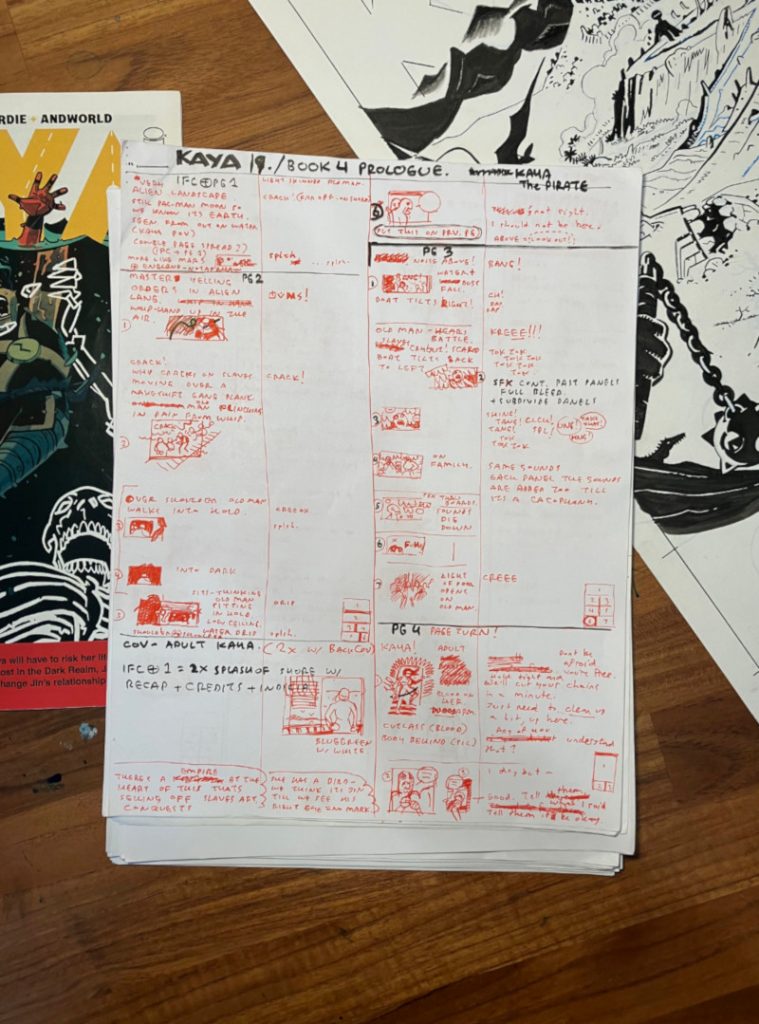
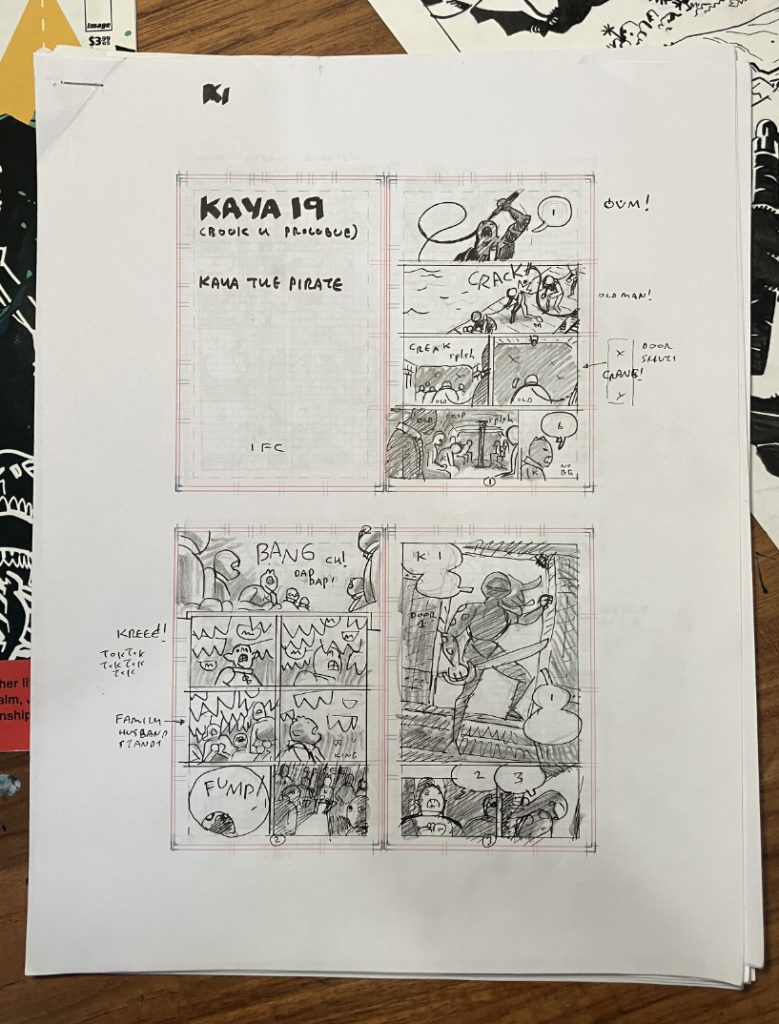
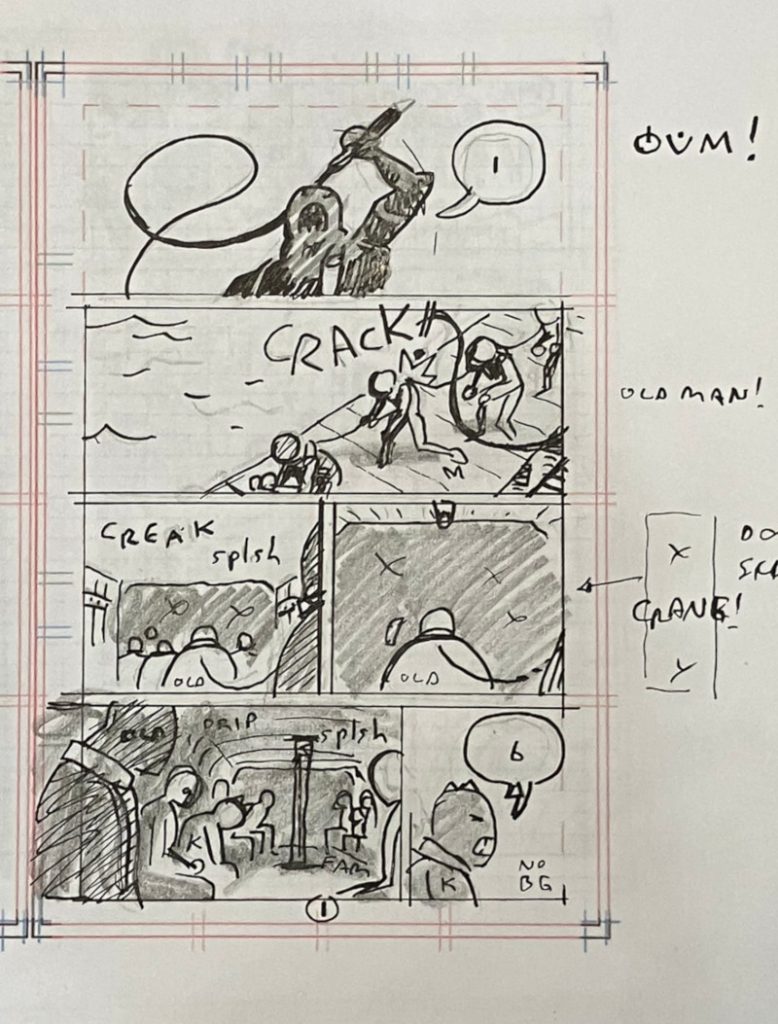
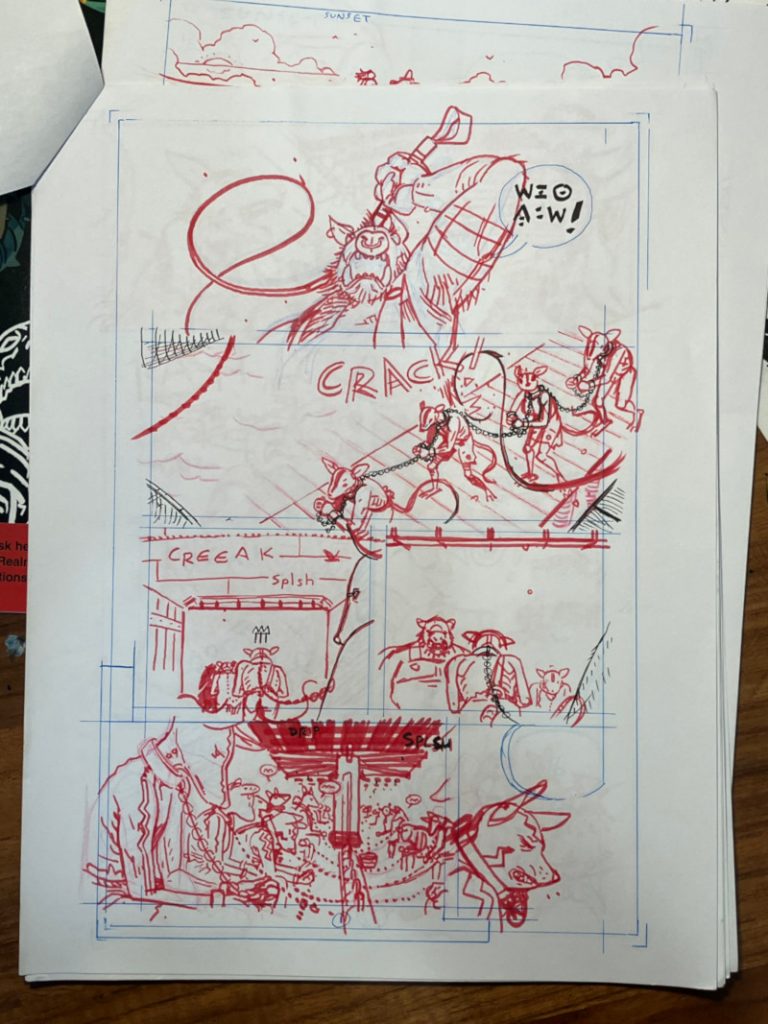
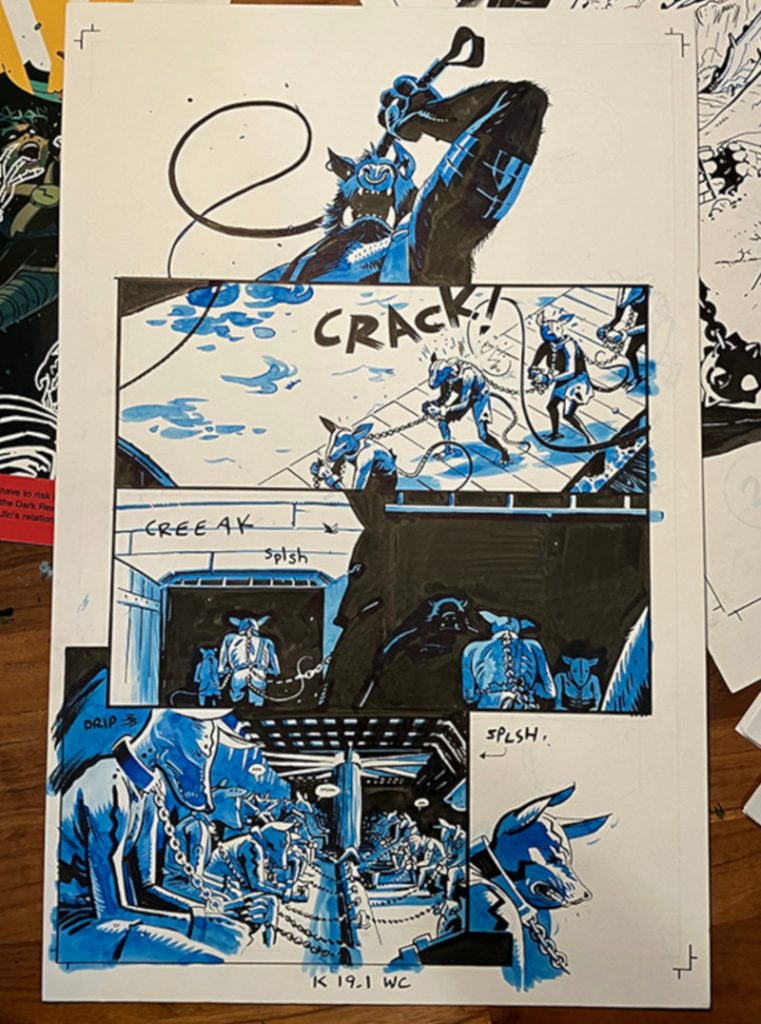
Let’s talk about overall process. When you get to putting together an issue or arc of Kaya, what’s your process like, from scripting to handing off to your collaborators?
Craig: I work on my script at the coffee shop, or sometimes at home, which often starts with ideas that come from just wandering around, or walking my dog, or going for a run. I write by hand on printer paper. Again, very weird way to work, but that’s how I find the ideas come most freely. It’s the opposite of staring at a computer screen for me, I just find that computer screen stifles the ideas somehow. Also, the computer has the almighty distractor, the internet, so the longer I can stay away from that, the more productive I can be. Until it’s research time, then the internet becomes the greatest tool ever invented.
I write the story out in beats, figuring out everything that needs to go in this arc or issue. Always trying to keep tabs of whether I’m writing is hitting me emotionally. My hope is if it hits me, then it’ll do the same to the reader. I break that down into pages. Only what has to happen on each page, so the highs and lows of the issue are clear in my head, kind of like reading sheet music (I imagine). Then I get into the story details, get into the heads of the characters. If they lead me a different direction than I planned out, I let that happen, and sometimes a scene is longer than I expects so then I have to edit down other scenes to make room. That stage of the writing is the most organic where I just try and let the characters do their thing and see where it goes.
I do thumbnails all in one go if possible. Then work from those to make the pencils and inks, like I described above. I scan it and fix it up in Photoshop and Jason Wordie adds his vibrant colors, Tom Naplolitano adds the perfect lettering, and Erika Schnatz from Image pulls it all together with her design work. They all do such an amazing job, I’m lucky to have them on the book.
How different does your approach and mindset have to be during each phase? Do you find your headspace to be considerably different during each?
Craig: It changes a lot. When I’m writing, I find time passes slower because I’m immersed in the world. When I’m drawing, because I usually have on a tv show or audiobook, I’m more aware of the outside world and time passes too fast. Writing takes full concentration, so do thumbnails, because it’s all problem solving. But once it’s mapped out in those stages, the drawing is a lot easier and I can be a bit distracted. Although honestly, the more immersed in the world you can be at all stages, the better it’ll turn out. So I’m trying to just take away all the outside stuff and just sink into the work, more and more. That’s easier in summer when I can open the windows and listen to the birds chirping. In the winter, the windows are closed and I feel a little isolated, so that’s when I need music, or podcasts or whatever.
Do you have a favorite phase of the process? And is there one that’s more important in your mind? The answer can absolutely be the same for both, of course!
Craig: My favorite stage is the writing because it’s only an hour a day, so I really cherish it. The drawing takes up more time and while I still love it, it does sometimes feel more like work after so many years. There’s that, and also my proficiency at drawing is at a point where there’s less big leaps in skill. I remember just after high school I felt like I was getting better at drawing and discovering new things all the time, every week. That was very exciting. And I feel a bit like that with the writing now, I still have so much room for improvement, but every month or two, I unlock some new aspect that improves the writing. So that feeling of getting better at your craft is the best. Very addictive.
You’ve been working in comics for a while, and in a number of different roles. Beyond simply writing your own work these days, has any part of your process shifted in a notable way over your career? If it has, why? Is it just about efficiencies, or is it something else?
Craig: I find my process is what it is now because of a slow evolution and just seeing what fits for me, what feels natural and is efficient, time-wise. Sometimes I try a different way of doing things, but usually t hat just reminds me why I have this process I’ve built, and then I just go back to it.
One thing that’s tough on a monthly schedule, is leaving room for experimentation. The whole thing about experiments is that sometimes they fail, and there’s not a lot of time on a monthly comic to go back and change something if it failed. So there’s less time for that. But experimenting is one of my favorite things to do in comics. So, for example, in Kaya, her brother Jin, goes to this place called the Dark Realm, every few issues, it might pop up. And that’s where I give myself some room to play around and try different materials, weird layouts, etc. Writing your own book allows that, you can work the stuff in that you know will keep you excited.
If you get up one day and find yourself lacking motivation or just not on point, what do you do? Do you have anything you turn to or do, beyond simply sitting down and forcing yourself to do the work?
Craig: It doesn’t really happen to me these days. Again, because of the nature of monthly comics, my mentality has to fit that goal. So my work is always the best I can do that day, not perfection. Perfection is kind of an illusion anyway, right? So I do the best I can that day and if there’s things I don’t like about it, well, I gotta do more tomorrow and the day after that, so there’s always another chance. Haha.
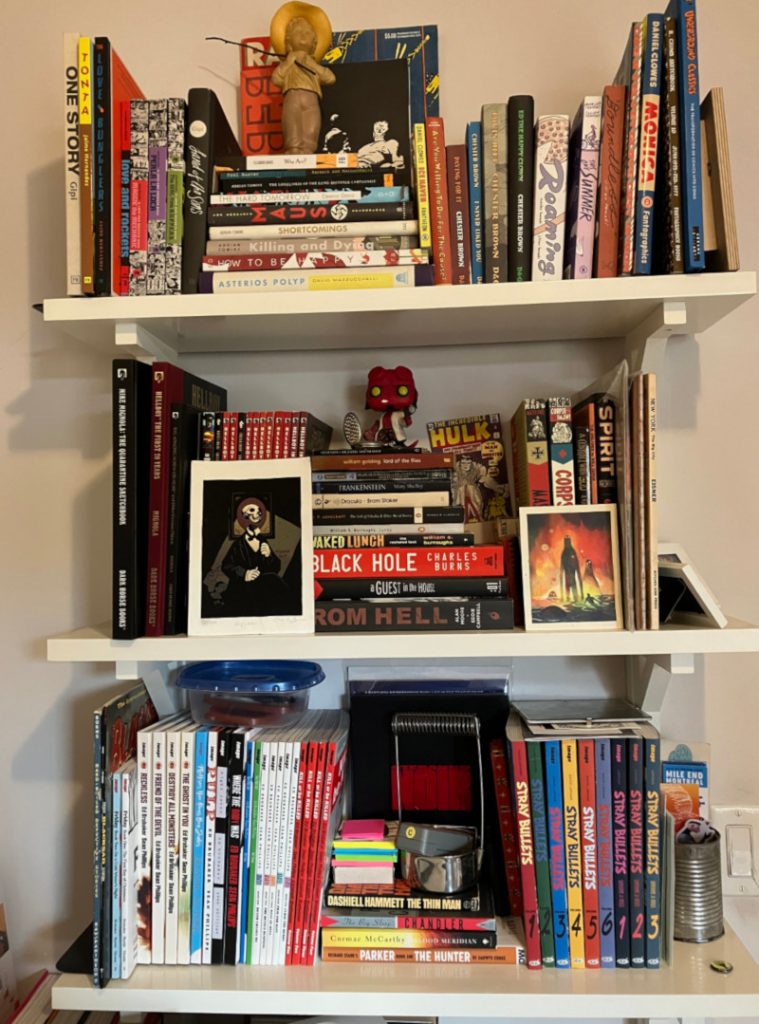
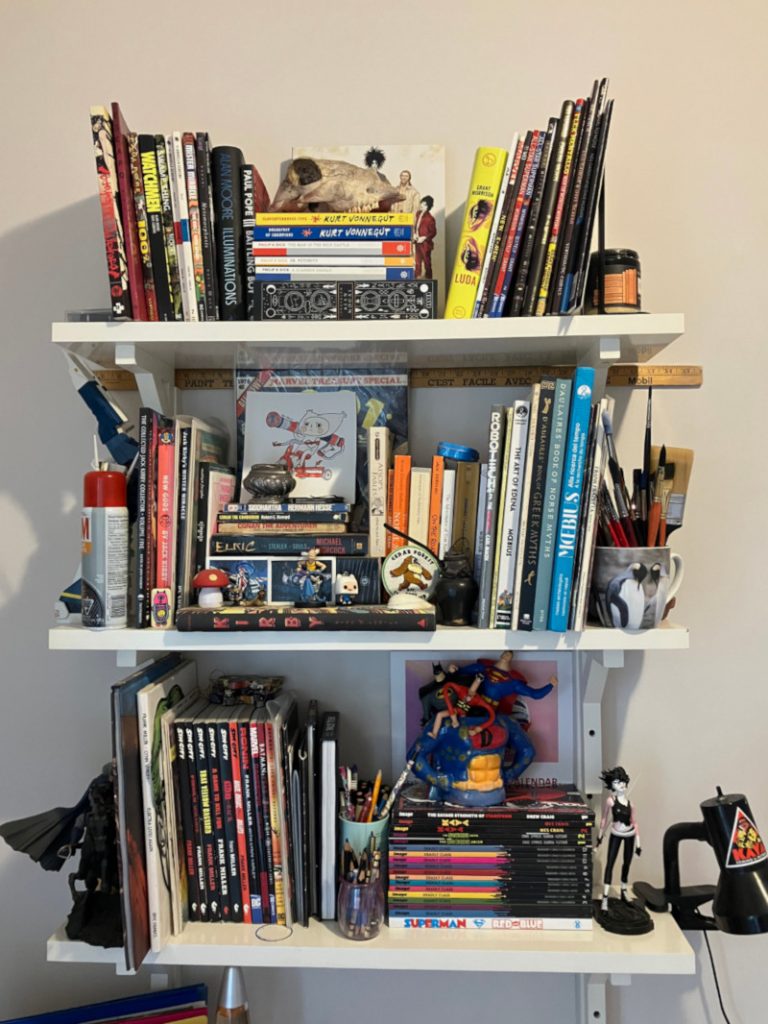
Are there any go to artists or books you specifically lean on if you’re in need of inspiration? Or does that depend on the project as well?
Craig: Depends on the project. I don’t really get writer block or artist’s block. But keeping around inspiration helps with that, I’m sure. Just like exposing yourself to new stuff will keep you moving forward and trying new things. For Deadly Class I was looking at a lot of old punk posters and designs, and a lot of Jamie Hernandez, David Mazzuchelli, Howard Chaykin, people who I associate with the late 80’s (or at least certain works of theirs that left an impression) also, they fit in that minimalist, Alex Toth school, which suited Deadly Class. Whereas for Kaya, it’s a lot more Mike Mignola, Frank Frazetta, Jack Kirby, stuff that suits the fantasy genre.
Making comics is a long process, and one that finds most working in isolation the majority of the time. That means most need something to complement the work. What do you listen to (or even watch) while you work? And does that shift during the different phases of your process?
Craig: I’m often listening to audiobooks that involve stuff I’m writing. Like right now I’m working on a story set in Feudal Japan that I want to pitch with an artist, so I’m listening to audiobooks on that world and trying to get a deeper understanding of how it worked. Then sometimes it’s rewatching a favorite tv show. Sometimes I just listen to dumb stuff on YouTube, but I’m trying to get away from that. But hey, we all need dumb stuff in our lives sometimes.
Do you make project or even arc specific soundtracks for Kaya, or do you have to mix it up depending on mood?
Craig: It’s whatever I feel like listening to in the moment, but when I’m really trying to get my head into that world there are certain go to’s. I listen to the soundtrack of Isle Of Dogs a lot. Those Japanese drums really fit Kaya’s world. Sometimes I’ll put on some punk when I want to focus on the speed and energy of a fight scene, stuff like that. But yeah, often it’s just whatever I feel like hearing that day.
Sometimes, people just need an escape, or something they do to reward themselves for finishing a page, issue, or even project. What you do to escape from work when you’re off the clock?
Craig: I hang out with my family. Play with my kids at the park. But even then, I’m thinking of ideas. I find it really pleasurable, so I don’t really look for many breaks. Sometimes you do get burned out, and that’s when I’ll actively decide not to draw or write anything for a few days. But that’s extremely rare. Between issues, sometimes I’ll take a one day break, and just wander the city, bring a book with me to read wherever, get some new comics, grab a coffee and doodle in my sketchbook if I feel like it. I love those days.
The short breaks help keep me excited to jump into the next issue.
If you enjoyed this interview, consider subscribing to SKTCHD for more features like it, and to support the work that I do.

